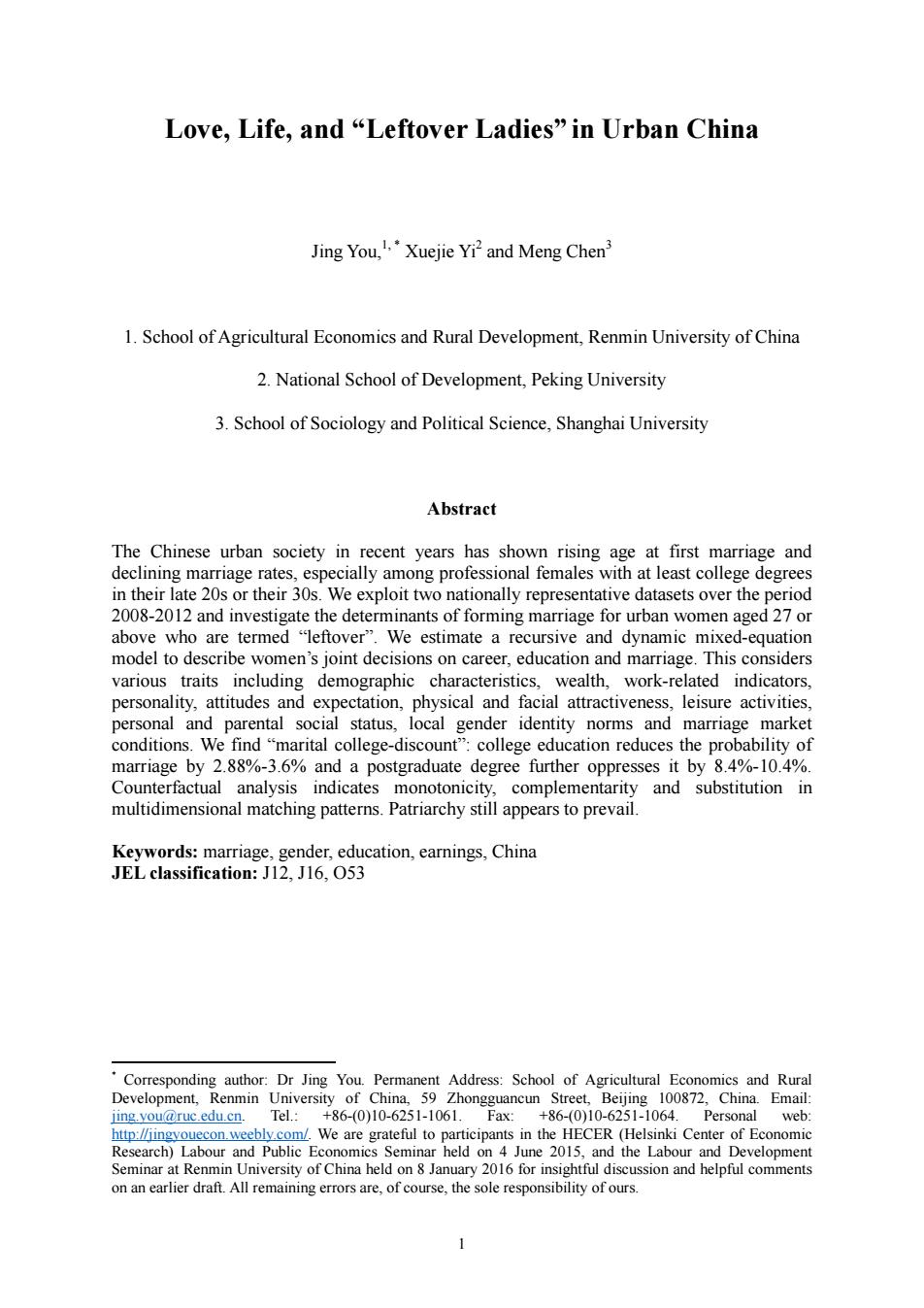
Love,Life,and "Leftover Ladies"in Urban China Jing You,.'Xuejie Yi and Meng Chen3 1.School of Agricultural Economics and Rural Development,Renmin University of China 2.National School of Development,Peking University 3.School of Sociology and Political Science,Shanghai University Abstract The Chinese urban society in recent years has shown rising age at first marriage and declining marriage rates,especially among professional females with at least college degrees in their late 20s or their 30s.We exploit two nationally representative datasets over the period 2008-2012 and investigate the determinants of forming marriage for urban women aged 27 or above who are termed "leftover".We estimate a recursive and dynamic mixed-equation model to describe women's joint decisions on career,education and marriage.This considers various traits including demographic characteristics,wealth,work-related indicators, personality,attitudes and expectation,physical and facial attractiveness,leisure activities, personal and parental social status,local gender identity norms and marriage market conditions.We find"marital college-discount":college education reduces the probability of marriage by 2.88%-3.6%and a postgraduate degree further oppresses it by 8.4%-10.4%. Counterfactual analysis indicates monotonicity,complementarity and substitution in multidimensional matching patterns.Patriarchy still appears to prevail. Keywords:marriage,gender,education,earnings,China JEL classification:J12.J16.O53 Corresponding author:Dr Jing You.Permanent Address:School of Agricultural Economics and Rural Development,Renmin University of China,59 Zhongguancun Street,Beijing 100872,China.Email: iing.vou@ruc.edu.cn.Tel.:+86-(0)10-6251-1061.Fax:+86-(0)10-6251-1064.Personal web: http://jingyouecon weebly com/.We are grateful to participants in the HECER (Helsinki Center of Economic Research)Labour and Public Economics Seminar held on 4 June 2015,and the Labour and Development Seminar at Renmin University of China held on 8 January 2016 for insightful discussion and helpful comments on an earlier draft.All remaining errors are,of course,the sole responsibility of ours
1 Love, Life, and “Leftover Ladies” in Urban China Jing You,1, * Xuejie Yi2 and Meng Chen3 1. School of Agricultural Economics and Rural Development, Renmin University of China 2. National School of Development, Peking University 3. School of Sociology and Political Science, Shanghai University Abstract The Chinese urban society in recent years has shown rising age at first marriage and declining marriage rates, especially among professional females with at least college degrees in their late 20s or their 30s. We exploit two nationally representative datasets over the period 2008-2012 and investigate the determinants of forming marriage for urban women aged 27 or above who are termed “leftover”. We estimate a recursive and dynamic mixed-equation model to describe women’s joint decisions on career, education and marriage. This considers various traits including demographic characteristics, wealth, work-related indicators, personality, attitudes and expectation, physical and facial attractiveness, leisure activities, personal and parental social status, local gender identity norms and marriage market conditions. We find “marital college-discount”: college education reduces the probability of marriage by 2.88%-3.6% and a postgraduate degree further oppresses it by 8.4%-10.4%. Counterfactual analysis indicates monotonicity, complementarity and substitution in multidimensional matching patterns. Patriarchy still appears to prevail. Keywords: marriage, gender, education, earnings, China JEL classification: J12, J16, O53 * Corresponding author: Dr Jing You. Permanent Address: School of Agricultural Economics and Rural Development, Renmin University of China, 59 Zhongguancun Street, Beijing 100872, China. Email: jing.you@ruc.edu.cn. Tel.: +86-(0)10-6251-1061. Fax: +86-(0)10-6251-1064. Personal web: http://jingyouecon.weebly.com/. We are grateful to participants in the HECER (Helsinki Center of Economic Research) Labour and Public Economics Seminar held on 4 June 2015, and the Labour and Development Seminar at Renmin University of China held on 8 January 2016 for insightful discussion and helpful comments on an earlier draft. All remaining errors are, of course, the sole responsibility of ours

Love,Life,and "Leftover Ladies"in Urban China Mediocrity is the virtue of women. Admonitions for Women(80 CE),by BAN Zhao(45-116 CE,China) 1.Introduction After more than three decades of economic reform,marriage remains universal and early in China (Ji and Yeung,2014;Jones and Gubhaju,2009).Yet,as with the other spheres of modern Chinese life,the marriage market has been evolving as part of the rapid,and, sometimes radical,socioeconomic transitions.Among the changes,the most visible features include two seemingly paradoxical phenomena:While the urban population of every province of the country reports higher-than-one sex ratio of unmarried men over unmarried women,urban women in their late 20s or 30s show decreasing rates of marriage formation. The 2010 Census suggests that three in ten urban women aged 25-29,long the most common age for urban women's first marriage in the Chinese tradition,had never been married, although there were 1.19 million more men than women in cities,contradicting the positive impact of sex ratio on the likelihood of women's marriage widely found in other countries (e.g.,U.S.in Angrist,2002 and Abramitzky et al.,2011). Researchers from various disciplinary backgrounds have documented the different situations Chinese men and women may face in the future.On the one hand,men of lower social status and less education will confront a deteriorating marital squeeze,with the rate of male bachelorhood predicted to peak around 2050(Guilmoto,2012;Huang,2014;Jiang, 2014);on the other,urban women,typically the well-educated,have to weigh the chance of marriage formation against their personal development in the public sphere (Ji,2015;Tian, 2013:Yu and Xie,2015). 2
2 Love, Life, and “Leftover Ladies” in Urban China Mediocrity is the virtue of women. Admonitions for Women (80 CE), by BAN Zhao (45-116 CE, China) 1. Introduction After more than three decades of economic reform, marriage remains universal and early in China (Ji and Yeung, 2014; Jones and Gubhaju, 2009). Yet, as with the other spheres of modern Chinese life, the marriage market has been evolving as part of the rapid, and, sometimes radical, socioeconomic transitions. Among the changes, the most visible features include two seemingly paradoxical phenomena: While the urban population of every province of the country reports higher-than-one sex ratio of unmarried men over unmarried women, urban women in their late 20s or 30s show decreasing rates of marriage formation. The 2010 Census suggests that three in ten urban women aged 25-29, long the most common age for urban women’s first marriage in the Chinese tradition, had never been married, although there were 1.19 million more men than women in cities, contradicting the positive impact of sex ratio on the likelihood of women’s marriage widely found in other countries (e.g., U.S. in Angrist, 2002 and Abramitzky et al., 2011). Researchers from various disciplinary backgrounds have documented the different situations Chinese men and women may face in the future. On the one hand, men of lower social status and less education will confront a deteriorating marital squeeze, with the rate of male bachelorhood predicted to peak around 2050 (Guilmoto, 2012; Huang, 2014; Jiang, 2014); on the other, urban women, typically the well-educated, have to weigh the chance of marriage formation against their personal development in the public sphere (Ji, 2015; Tian, 2013; Yu and Xie, 2015)
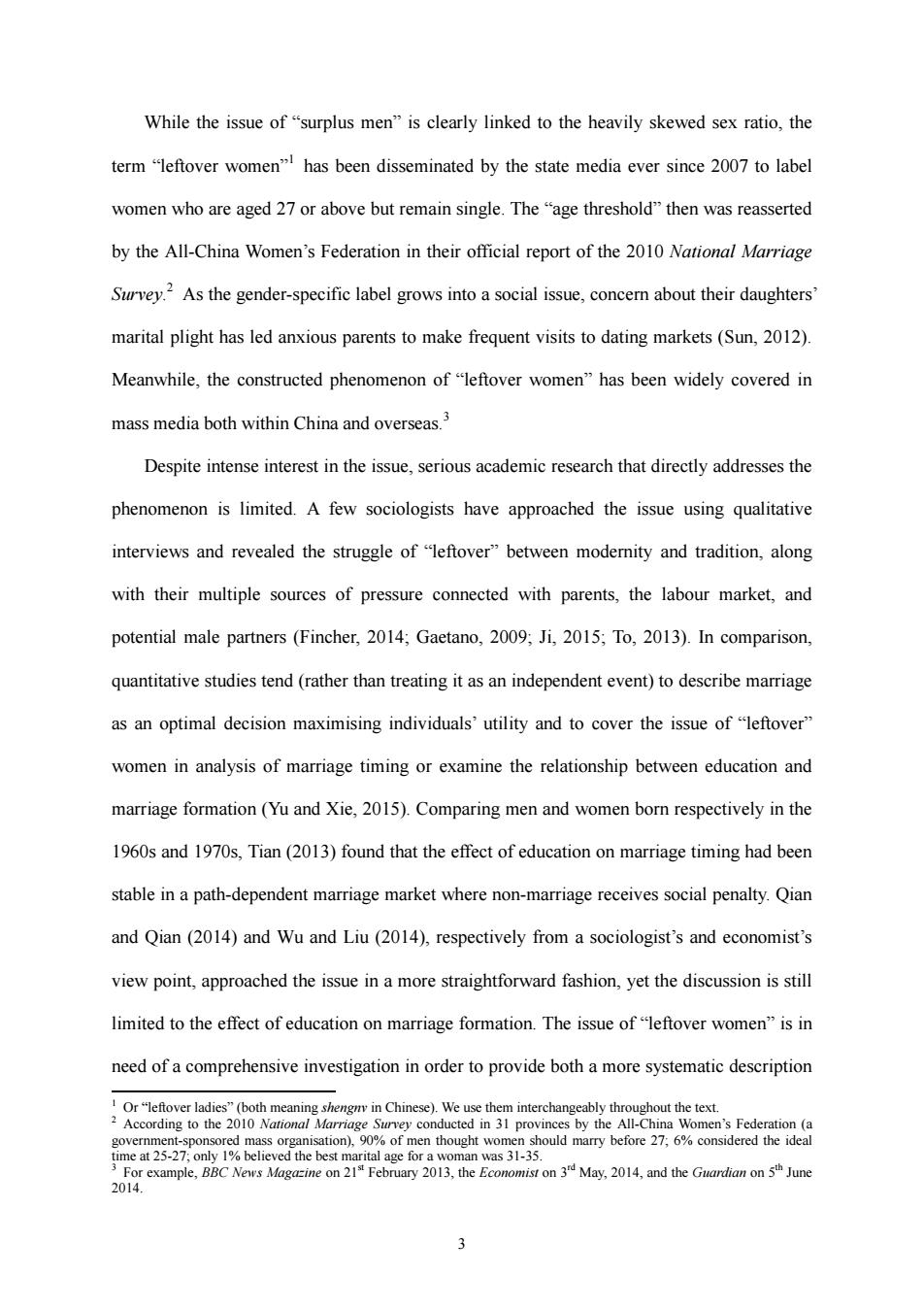
While the issue of"surplus men"is clearly linked to the heavily skewed sex ratio,the term "leftover women"has been disseminated by the state media ever since 2007 to label women who are aged 27 or above but remain single.The "age threshold"then was reasserted by the All-China Women's Federation in their official report of the 2010 National Marriage Survey.2 As the gender-specific label grows into a social issue,concern about their daughters' marital plight has led anxious parents to make frequent visits to dating markets(Sun,2012). Meanwhile,the constructed phenomenon of"leftover women"has been widely covered in mass media both within China and overseas.3 Despite intense interest in the issue,serious academic research that directly addresses the phenomenon is limited.A few sociologists have approached the issue using qualitative interviews and revealed the struggle of"leftover"between modernity and tradition,along with their multiple sources of pressure connected with parents,the labour market,and potential male partners (Fincher,2014;Gaetano,2009;Ji,2015;To,2013).In comparison, quantitative studies tend(rather than treating it as an independent event)to describe marriage as an optimal decision maximising individuals'utility and to cover the issue of "leftover" women in analysis of marriage timing or examine the relationship between education and marriage formation(Yu and Xie,2015).Comparing men and women born respectively in the 1960s and 1970s,Tian(2013)found that the effect of education on marriage timing had been stable in a path-dependent marriage market where non-marriage receives social penalty.Qian and Qian (2014)and Wu and Liu (2014),respectively from a sociologist's and economist's view point,approached the issue in a more straightforward fashion,yet the discussion is still limited to the effect of education on marriage formation.The issue of"leftover women"is in need of a comprehensive investigation in order to provide both a more systematic description Or"leftover ladies"(both meaning shengm in Chinese).We use them interchangeably throughout the text. 2 According to the 2010 Narional Marriage Survey conducted in 31 provinces by the All-China Women's Federation (a government-sponsored mass organisation),90%of men thought women should marry before 27;6%considered the ideal time at 25-27;only 1%believed the best marital age for a woman was 31-35. 3 For example,BBC News Magaine on21 February 2013,the Economist on 3 May,2014,and the Guardian on 5 June 2014. 3
3 While the issue of “surplus men” is clearly linked to the heavily skewed sex ratio, the term “leftover women”1 has been disseminated by the state media ever since 2007 to label women who are aged 27 or above but remain single. The “age threshold” then was reasserted by the All-China Women’s Federation in their official report of the 2010 National Marriage Survey. 2 As the gender-specific label grows into a social issue, concern about their daughters’ marital plight has led anxious parents to make frequent visits to dating markets (Sun, 2012). Meanwhile, the constructed phenomenon of “leftover women” has been widely covered in mass media both within China and overseas.3 Despite intense interest in the issue, serious academic research that directly addresses the phenomenon is limited. A few sociologists have approached the issue using qualitative interviews and revealed the struggle of “leftover” between modernity and tradition, along with their multiple sources of pressure connected with parents, the labour market, and potential male partners (Fincher, 2014; Gaetano, 2009; Ji, 2015; To, 2013). In comparison, quantitative studies tend (rather than treating it as an independent event) to describe marriage as an optimal decision maximising individuals’ utility and to cover the issue of “leftover” women in analysis of marriage timing or examine the relationship between education and marriage formation (Yu and Xie, 2015). Comparing men and women born respectively in the 1960s and 1970s, Tian (2013) found that the effect of education on marriage timing had been stable in a path-dependent marriage market where non-marriage receives social penalty. Qian and Qian (2014) and Wu and Liu (2014), respectively from a sociologist’s and economist’s view point, approached the issue in a more straightforward fashion, yet the discussion is still limited to the effect of education on marriage formation. The issue of “leftover women” is in need of a comprehensive investigation in order to provide both a more systematic description 1 Or “leftover ladies” (both meaning shengnv in Chinese). We use them interchangeably throughout the text. 2 According to the 2010 National Marriage Survey conducted in 31 provinces by the All-China Women’s Federation (a government-sponsored mass organisation), 90% of men thought women should marry before 27; 6% considered the ideal time at 25-27; only 1% believed the best marital age for a woman was 31-35. 3 For example, BBC News Magazine on 21st February 2013, the Economist on 3rd May, 2014, and the Guardian on 5th June 2014
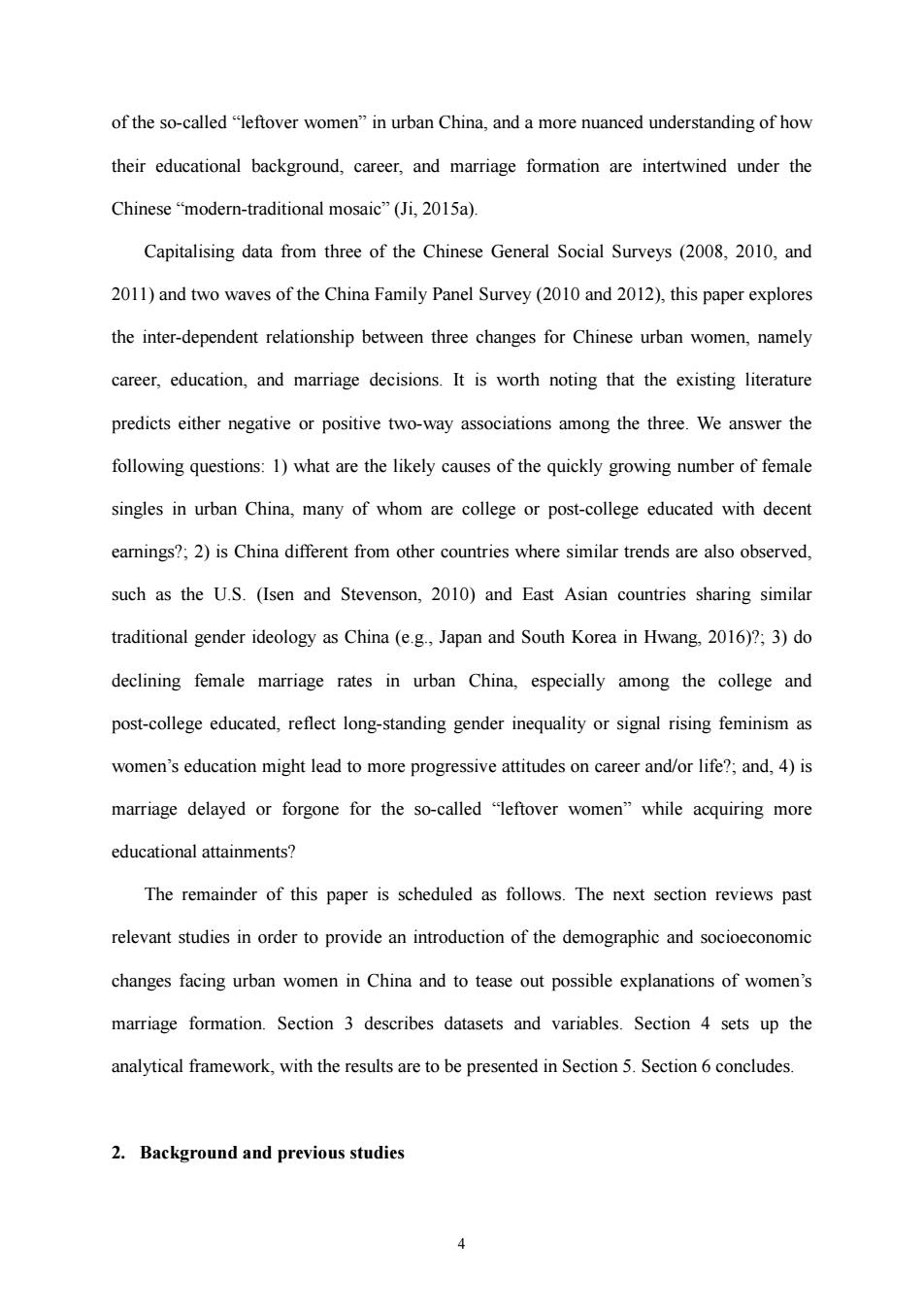
of the so-called "leftover women"in urban China,and a more nuanced understanding of how their educational background,career,and marriage formation are intertwined under the Chinese "modern-traditional mosaic"(Ji,2015a) Capitalising data from three of the Chinese General Social Surveys (2008,2010,and 2011)and two waves of the China Family Panel Survey(2010 and 2012),this paper explores the inter-dependent relationship between three changes for Chinese urban women,namely career,education,and marriage decisions.It is worth noting that the existing literature predicts either negative or positive two-way associations among the three.We answer the following questions:1)what are the likely causes of the quickly growing number of female singles in urban China,many of whom are college or post-college educated with decent earnings?;2)is China different from other countries where similar trends are also observed, such as the U.S.(Isen and Stevenson,2010)and East Asian countries sharing similar traditional gender ideology as China (e.g.,Japan and South Korea in Hwang,2016)?;3)do declining female marriage rates in urban China,especially among the college and post-college educated,reflect long-standing gender inequality or signal rising feminism as women's education might lead to more progressive attitudes on career and/or life?;and,4)is marriage delayed or forgone for the so-called "leftover women"while acquiring more educational attainments? The remainder of this paper is scheduled as follows.The next section reviews past relevant studies in order to provide an introduction of the demographic and socioeconomic changes facing urban women in China and to tease out possible explanations of women's marriage formation.Section 3 describes datasets and variables.Section 4 sets up the analytical framework,with the results are to be presented in Section 5.Section 6 concludes. 2.Background and previous studies 4
4 of the so-called “leftover women” in urban China, and a more nuanced understanding of how their educational background, career, and marriage formation are intertwined under the Chinese “modern-traditional mosaic” (Ji, 2015a). Capitalising data from three of the Chinese General Social Surveys (2008, 2010, and 2011) and two waves of the China Family Panel Survey (2010 and 2012), this paper explores the inter-dependent relationship between three changes for Chinese urban women, namely career, education, and marriage decisions. It is worth noting that the existing literature predicts either negative or positive two-way associations among the three. We answer the following questions: 1) what are the likely causes of the quickly growing number of female singles in urban China, many of whom are college or post-college educated with decent earnings?; 2) is China different from other countries where similar trends are also observed, such as the U.S. (Isen and Stevenson, 2010) and East Asian countries sharing similar traditional gender ideology as China (e.g., Japan and South Korea in Hwang, 2016)?; 3) do declining female marriage rates in urban China, especially among the college and post-college educated, reflect long-standing gender inequality or signal rising feminism as women’s education might lead to more progressive attitudes on career and/or life?; and, 4) is marriage delayed or forgone for the so-called “leftover women” while acquiring more educational attainments? The remainder of this paper is scheduled as follows. The next section reviews past relevant studies in order to provide an introduction of the demographic and socioeconomic changes facing urban women in China and to tease out possible explanations of women’s marriage formation. Section 3 describes datasets and variables. Section 4 sets up the analytical framework, with the results are to be presented in Section 5. Section 6 concludes. 2. Background and previous studies
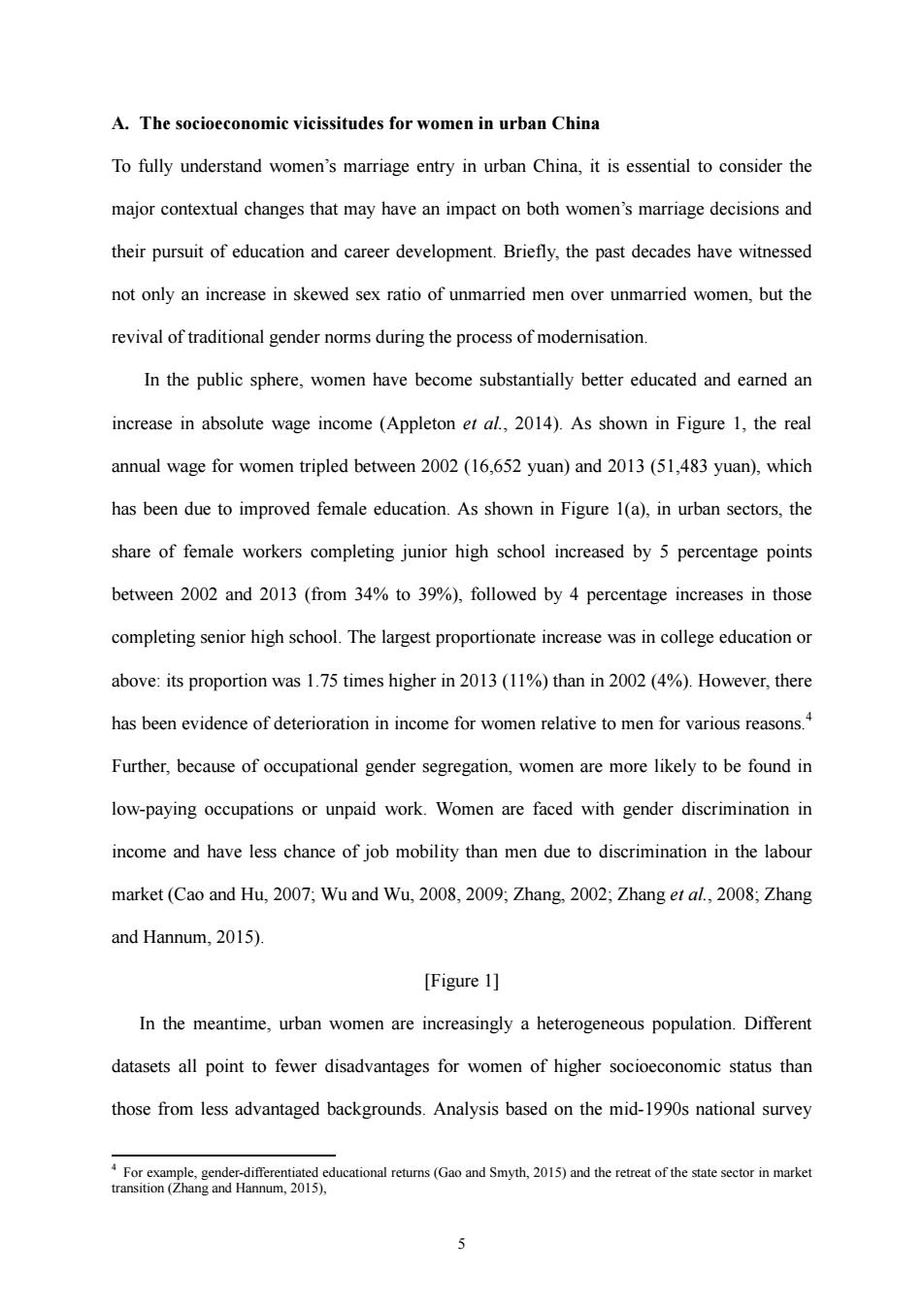
A.The socioeconomic vicissitudes for women in urban China To fully understand women's marriage entry in urban China,it is essential to consider the major contextual changes that may have an impact on both women's marriage decisions and their pursuit of education and career development.Briefly,the past decades have witnessed not only an increase in skewed sex ratio of unmarried men over unmarried women,but the revival of traditional gender norms during the process of modernisation. In the public sphere,women have become substantially better educated and earned an increase in absolute wage income (Appleton et al.,2014).As shown in Figure 1,the real annual wage for women tripled between 2002(16,652 yuan)and 2013(51,483 yuan),which has been due to improved female education.As shown in Figure 1(a),in urban sectors,the share of female workers completing junior high school increased by 5 percentage points between 2002 and 2013(from 34%to 39%),followed by 4 percentage increases in those completing senior high school.The largest proportionate increase was in college education or above:its proportion was 1.75 times higher in 2013(11%)than in 2002(4%).However,there has been evidence of deterioration in income for women relative to men for various reasons.4 Further,because of occupational gender segregation,women are more likely to be found in low-paying occupations or unpaid work.Women are faced with gender discrimination in income and have less chance of job mobility than men due to discrimination in the labour market(Cao and Hu,2007:Wu and Wu,2008,2009;Zhang,2002;Zhang et al.,2008;Zhang and Hannum,2015). [Figure 1] In the meantime,urban women are increasingly a heterogeneous population.Different datasets all point to fewer disadvantages for women of higher socioeconomic status than those from less advantaged backgrounds.Analysis based on the mid-1990s national survey 4For example,gender-differentiated educational retums(Gao and Smyth,2015)and the retreat of the state sector in market transition (Zhang and Hannum,2015)
5 A. The socioeconomic vicissitudes for women in urban China To fully understand women’s marriage entry in urban China, it is essential to consider the major contextual changes that may have an impact on both women’s marriage decisions and their pursuit of education and career development. Briefly, the past decades have witnessed not only an increase in skewed sex ratio of unmarried men over unmarried women, but the revival of traditional gender norms during the process of modernisation. In the public sphere, women have become substantially better educated and earned an increase in absolute wage income (Appleton et al., 2014). As shown in Figure 1, the real annual wage for women tripled between 2002 (16,652 yuan) and 2013 (51,483 yuan), which has been due to improved female education. As shown in Figure 1(a), in urban sectors, the share of female workers completing junior high school increased by 5 percentage points between 2002 and 2013 (from 34% to 39%), followed by 4 percentage increases in those completing senior high school. The largest proportionate increase was in college education or above: its proportion was 1.75 times higher in 2013 (11%) than in 2002 (4%). However, there has been evidence of deterioration in income for women relative to men for various reasons.4 Further, because of occupational gender segregation, women are more likely to be found in low-paying occupations or unpaid work. Women are faced with gender discrimination in income and have less chance of job mobility than men due to discrimination in the labour market (Cao and Hu, 2007; Wu and Wu, 2008, 2009; Zhang, 2002; Zhang et al., 2008; Zhang and Hannum, 2015). [Figure 1] In the meantime, urban women are increasingly a heterogeneous population. Different datasets all point to fewer disadvantages for women of higher socioeconomic status than those from less advantaged backgrounds. Analysis based on the mid-1990s national survey 4 For example, gender-differentiated educational returns (Gao and Smyth, 2015) and the retreat of the state sector in market transition (Zhang and Hannum, 2015)
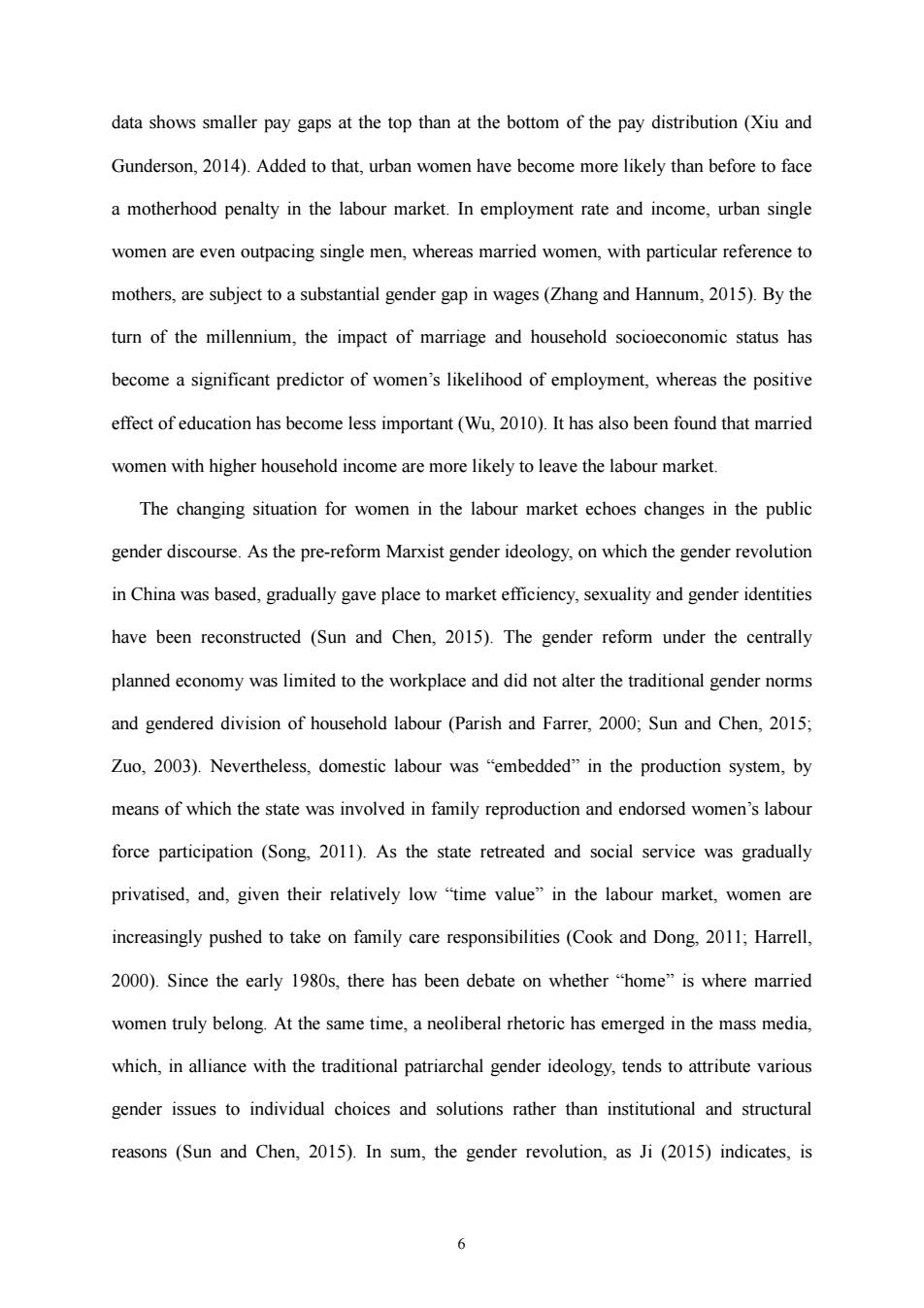
data shows smaller pay gaps at the top than at the bottom of the pay distribution (Xiu and Gunderson,2014).Added to that,urban women have become more likely than before to face a motherhood penalty in the labour market.In employment rate and income,urban single women are even outpacing single men,whereas married women,with particular reference to mothers,are subject to a substantial gender gap in wages(Zhang and Hannum,2015).By the turn of the millennium,the impact of marriage and household socioeconomic status has become a significant predictor of women's likelihood of employment,whereas the positive effect of education has become less important(Wu,2010).It has also been found that married women with higher household income are more likely to leave the labour market. The changing situation for women in the labour market echoes changes in the public gender discourse.As the pre-reform Marxist gender ideology,on which the gender revolution in China was based,gradually gave place to market efficiency,sexuality and gender identities have been reconstructed (Sun and Chen,2015).The gender reform under the centrally planned economy was limited to the workplace and did not alter the traditional gender norms and gendered division of household labour(Parish and Farrer,2000;Sun and Chen,2015; Zuo,2003).Nevertheless,domestic labour was "embedded"in the production system,by means of which the state was involved in family reproduction and endorsed women's labour force participation (Song,2011).As the state retreated and social service was gradually privatised,and,given their relatively low "time value"in the labour market,women are increasingly pushed to take on family care responsibilities (Cook and Dong,2011;Harrell, 2000).Since the early 1980s,there has been debate on whether "home"is where married women truly belong.At the same time,a neoliberal rhetoric has emerged in the mass media, which,in alliance with the traditional patriarchal gender ideology,tends to attribute various gender issues to individual choices and solutions rather than institutional and structural reasons (Sun and Chen,2015).In sum,the gender revolution,as Ji (2015)indicates,is 6
6 data shows smaller pay gaps at the top than at the bottom of the pay distribution (Xiu and Gunderson, 2014). Added to that, urban women have become more likely than before to face a motherhood penalty in the labour market. In employment rate and income, urban single women are even outpacing single men, whereas married women, with particular reference to mothers, are subject to a substantial gender gap in wages (Zhang and Hannum, 2015). By the turn of the millennium, the impact of marriage and household socioeconomic status has become a significant predictor of women’s likelihood of employment, whereas the positive effect of education has become less important (Wu, 2010). It has also been found that married women with higher household income are more likely to leave the labour market. The changing situation for women in the labour market echoes changes in the public gender discourse. As the pre-reform Marxist gender ideology, on which the gender revolution in China was based, gradually gave place to market efficiency, sexuality and gender identities have been reconstructed (Sun and Chen, 2015). The gender reform under the centrally planned economy was limited to the workplace and did not alter the traditional gender norms and gendered division of household labour (Parish and Farrer, 2000; Sun and Chen, 2015; Zuo, 2003). Nevertheless, domestic labour was “embedded” in the production system, by means of which the state was involved in family reproduction and endorsed women’s labour force participation (Song, 2011). As the state retreated and social service was gradually privatised, and, given their relatively low “time value” in the labour market, women are increasingly pushed to take on family care responsibilities (Cook and Dong, 2011; Harrell, 2000). Since the early 1980s, there has been debate on whether “home” is where married women truly belong. At the same time, a neoliberal rhetoric has emerged in the mass media, which, in alliance with the traditional patriarchal gender ideology, tends to attribute various gender issues to individual choices and solutions rather than institutional and structural reasons (Sun and Chen, 2015). In sum, the gender revolution, as Ji (2015) indicates, is
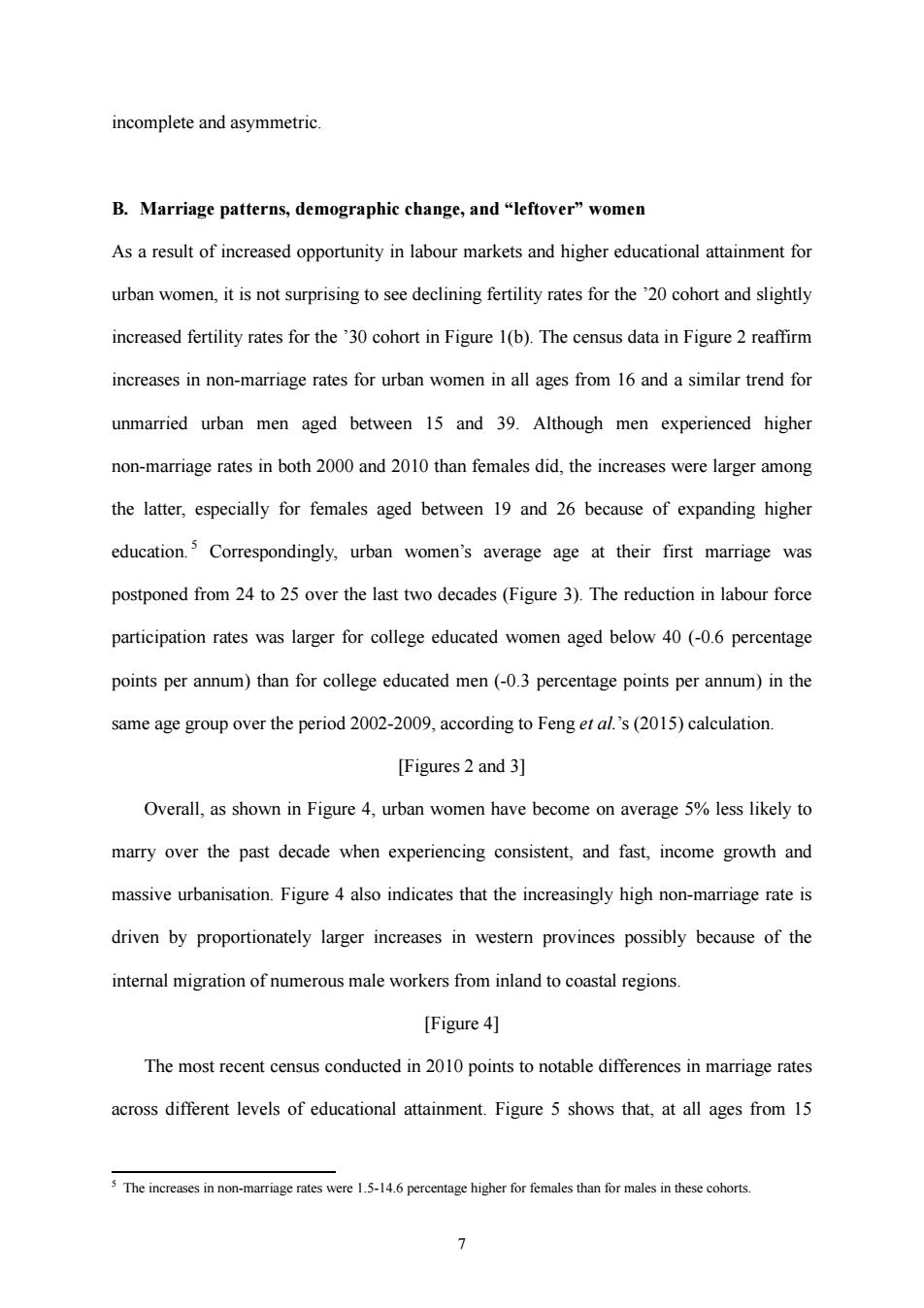
incomplete and asymmetric. B.Marriage patterns,demographic change,and "leftover"women As a result of increased opportunity in labour markets and higher educational attainment for urban women,it is not surprising to see declining fertility rates for the'20 cohort and slightly increased fertility rates for the'30 cohort in Figure 1(b).The census data in Figure 2 reaffirm increases in non-marriage rates for urban women in all ages from 16 and a similar trend for unmarried urban men aged between 15 and 39.Although men experienced higher non-marriage rates in both 2000 and 2010 than females did,the increases were larger among the latter,especially for females aged between 19 and 26 because of expanding higher education.3 Correspondingly,urban women's average age at their first marriage was postponed from 24 to 25 over the last two decades(Figure 3).The reduction in labour force participation rates was larger for college educated women aged below 40(-0.6 percentage points per annum)than for college educated men(-0.3 percentage points per annum)in the same age group over the period 2002-2009,according to Feng et al.'s(2015)calculation. [Figures 2 and 3] Overall,as shown in Figure 4,urban women have become on average 5%less likely to marry over the past decade when experiencing consistent,and fast,income growth and massive urbanisation.Figure 4 also indicates that the increasingly high non-marriage rate is driven by proportionately larger increases in western provinces possibly because of the internal migration of numerous male workers from inland to coastal regions. [Figure 4] The most recent census conducted in 2010 points to notable differences in marriage rates across different levels of educational attainment.Figure 5 shows that,at all ages from 15 5 The increases in non-marriage rates were 1.5-14.6 percentage higher for females than for males in these cohorts. >
7 incomplete and asymmetric. B. Marriage patterns, demographic change, and “leftover” women As a result of increased opportunity in labour markets and higher educational attainment for urban women, it is not surprising to see declining fertility rates for the ’20 cohort and slightly increased fertility rates for the ’30 cohort in Figure 1(b). The census data in Figure 2 reaffirm increases in non-marriage rates for urban women in all ages from 16 and a similar trend for unmarried urban men aged between 15 and 39. Although men experienced higher non-marriage rates in both 2000 and 2010 than females did, the increases were larger among the latter, especially for females aged between 19 and 26 because of expanding higher education. 5 Correspondingly, urban women’s average age at their first marriage was postponed from 24 to 25 over the last two decades (Figure 3). The reduction in labour force participation rates was larger for college educated women aged below 40 (-0.6 percentage points per annum) than for college educated men (-0.3 percentage points per annum) in the same age group over the period 2002-2009, according to Feng et al.’s (2015) calculation. [Figures 2 and 3] Overall, as shown in Figure 4, urban women have become on average 5% less likely to marry over the past decade when experiencing consistent, and fast, income growth and massive urbanisation. Figure 4 also indicates that the increasingly high non-marriage rate is driven by proportionately larger increases in western provinces possibly because of the internal migration of numerous male workers from inland to coastal regions. [Figure 4] The most recent census conducted in 2010 points to notable differences in marriage rates across different levels of educational attainment. Figure 5 shows that, at all ages from 15 5 The increases in non-marriage rates were 1.5-14.6 percentage higher for females than for males in these cohorts

regardless of gender,the higher the individual's educational attainment,the higher the likelihood of remaining unmarried.For individuals of all educational levels,the increases in this likelihood are larger for women than for men.Two cohorts seem to be least likely to get married older-the least educated men (with primary education)and well-educated women (with postgraduate degrees),and the non-marriage rate is even higher for the former than for the latter in their 40s.Interestingly,the 2010 census points to a "turning point"for the well-educated:even though men in general face higher non-marriage rates of non-marriage than women of most educational levels,women with postgraduate degrees are even less likely to marry after 35 than men of the same level of education and age.In this sense, marriage may not simply be delayed,but may be forgone for post-college educated female singles(Cf.Wu and Liu,2014). [Figure 5] Those changes in marriage patterns also accompany mate selection.They not only are natural consequences of social development,but also reflect the aforementioned gendered dichotomy between the public sphere and private sphere in urban China.Over the decades, apart from delaying marriage,single men and women in urban China also adjusted their criteria for mate selection.Using the survey data of two major cities,Xu(2000)showed that urban young people were paying more attention to the socioeconomic and material circumstances of their potential partners.Later,Li (2008,2011)found that educational homogamy had become more pervasive since the 1980s.While the match between family socioeconomic background apparently becomes less important,the pressure of uncertainty in a market society has pushed marriage searchers to prioritise their future partner's career and financial achievement as well as the potential.These results were reconfirmed by more recent data (Ma,2015;Qi and Niu,2015).Ma's(2015)analysis of the national data shows that more than half Chinese marriages feature husband and wife in similar tiers of education,social
8 regardless of gender, the higher the individual’s educational attainment, the higher the likelihood of remaining unmarried. For individuals of all educational levels, the increases in this likelihood are larger for women than for men. Two cohorts seem to be least likely to get married older – the least educated men (with primary education) and well-educated women (with postgraduate degrees), and the non-marriage rate is even higher for the former than for the latter in their 40s. Interestingly, the 2010 census points to a “turning point” for the well-educated: even though men in general face higher non-marriage rates of non-marriage than women of most educational levels, women with postgraduate degrees are even less likely to marry after 35 than men of the same level of education and age. In this sense, marriage may not simply be delayed, but may be forgone for post-college educated female singles (Cf. Wu and Liu, 2014). [Figure 5] Those changes in marriage patterns also accompany mate selection. They not only are natural consequences of social development, but also reflect the aforementioned gendered dichotomy between the public sphere and private sphere in urban China. Over the decades, apart from delaying marriage, single men and women in urban China also adjusted their criteria for mate selection. Using the survey data of two major cities, Xu (2000) showed that urban young people were paying more attention to the socioeconomic and material circumstances of their potential partners. Later, Li (2008, 2011) found that educational homogamy had become more pervasive since the 1980s. While the match between family socioeconomic background apparently becomes less important, the pressure of uncertainty in a market society has pushed marriage searchers to prioritise their future partner’s career and financial achievement as well as the potential. These results were reconfirmed by more recent data (Ma, 2015; Qi and Niu, 2015). Ma’s (2015) analysis of the national data shows that more than half Chinese marriages feature husband and wife in similar tiers of education, social

class,and income.That said,the common phenomenon of women "marrying up"indicates the persistence of patriarchal gender norms in the Chinese marriage market. Despite their improved achievement in education and career,single women often have to cope with pressure from multiple sources in the "traditional-modern mosaic"(Ji,2015).As revealed by Ji's qualitative interview data,it is not uncommon for single women to have parents who invested for years into their daughter's education and so are reluctant to lower their expectations of a future son-in-law.Meanwhile,however,such single women may also be subject to discrimination in the marriage market if they do not seem willing to take on the Chinese traditional wifely role (To,2013).Constrained by the "gendered double standard of ageing"(England and McClintock,2009;Ji,2015),well-educated single women who are keen to achieve career advancement have to achieve a delicate balance between timing their marriage at the proper age and pursuing a career while they are still considered"able"female employees. To gain a comprehensive understanding of the phenomenon of "leftover women",it is also essential to frame the issue in the overall social context in which urban Chinese women live.In addition to the possibility of encountering "discriminatory"and "controlling"suitors in the marriage market,single women are also faced with the changing public discourse concerning married women and mothers,which extends the aforementioned traditional family-centered role of Chinese women.In contrast to the image of"degendered""Iron Girl" mothers,working mothers in the modern Chinese market society are expected to practice "intense motherhood"and be versatile enough to meet new demands ranging from earning a high income (long been supposed to be shouldered by men)to being a perfect family educator for their children (Jin and Yang,2015;Murphy,2000).As urban mothers are constantly reminded of the importance of giving their family and children unquestioned priority,another dimension of gender essentialism,has emerged in the apparent discourse of 9
9 class, and income. That said, the common phenomenon of women “marrying up” indicates the persistence of patriarchal gender norms in the Chinese marriage market. Despite their improved achievement in education and career, single women often have to cope with pressure from multiple sources in the “traditional-modern mosaic” (Ji, 2015). As revealed by Ji’s qualitative interview data, it is not uncommon for single women to have parents who invested for years into their daughter’s education and so are reluctant to lower their expectations of a future son-in-law. Meanwhile, however, such single women may also be subject to discrimination in the marriage market if they do not seem willing to take on the Chinese traditional wifely role (To, 2013). Constrained by the “gendered double standard of ageing” (England and McClintock, 2009; Ji, 2015), well-educated single women who are keen to achieve career advancement have to achieve a delicate balance between timing their marriage at the proper age and pursuing a career while they are still considered “able” female employees. To gain a comprehensive understanding of the phenomenon of “leftover women”, it is also essential to frame the issue in the overall social context in which urban Chinese women live. In addition to the possibility of encountering “discriminatory” and “controlling” suitors in the marriage market, single women are also faced with the changing public discourse concerning married women and mothers, which extends the aforementioned traditional family-centered role of Chinese women. In contrast to the image of “degendered” “Iron Girl” mothers, working mothers in the modern Chinese market society are expected to practice “intense motherhood” and be versatile enough to meet new demands ranging from earning a high income (long been supposed to be shouldered by men) to being a perfect family educator for their children (Jin and Yang, 2015; Murphy, 2000). As urban mothers are constantly reminded of the importance of giving their family and children unquestioned priority, another dimension of gender essentialism, has emerged in the apparent discourse of
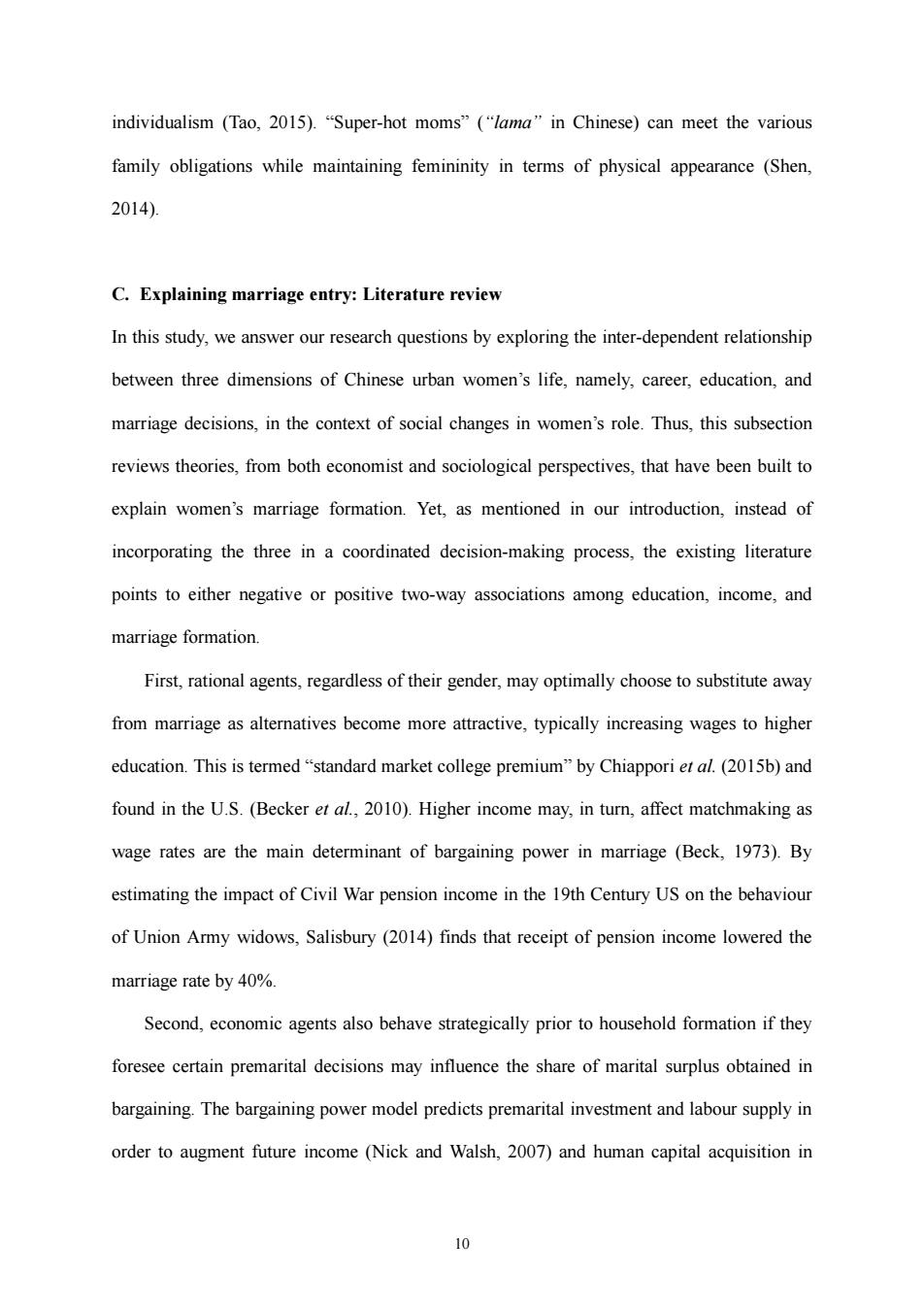
individualism(Tao,20lS).“Super-hot moms”(“lama”in Chinese)can meet the various family obligations while maintaining femininity in terms of physical appearance (Shen, 2014). C.Explaining marriage entry:Literature review In this study,we answer our research questions by exploring the inter-dependent relationship between three dimensions of Chinese urban women's life,namely,career,education,and marriage decisions,in the context of social changes in women's role.Thus,this subsection reviews theories,from both economist and sociological perspectives,that have been built to explain women's marriage formation.Yet,as mentioned in our introduction,instead of incorporating the three in a coordinated decision-making process,the existing literature points to either negative or positive two-way associations among education,income,and marriage formation. First,rational agents,regardless of their gender,may optimally choose to substitute away from marriage as alternatives become more attractive,typically increasing wages to higher education.This is termed"standard market college premium"by Chiappori et al.(2015b)and found in the U.S.(Becker et al.,2010).Higher income may,in turn,affect matchmaking as wage rates are the main determinant of bargaining power in marriage (Beck,1973).By estimating the impact of Civil War pension income in the 19th Century US on the behaviour of Union Army widows,Salisbury (2014)finds that receipt of pension income lowered the marriage rate by 40%. Second,economic agents also behave strategically prior to household formation if they foresee certain premarital decisions may influence the share of marital surplus obtained in bargaining.The bargaining power model predicts premarital investment and labour supply in order to augment future income (Nick and Walsh,2007)and human capital acquisition in 10
10 individualism (Tao, 2015). “Super-hot moms” (“lama” in Chinese) can meet the various family obligations while maintaining femininity in terms of physical appearance (Shen, 2014). C. Explaining marriage entry: Literature review In this study, we answer our research questions by exploring the inter-dependent relationship between three dimensions of Chinese urban women’s life, namely, career, education, and marriage decisions, in the context of social changes in women’s role. Thus, this subsection reviews theories, from both economist and sociological perspectives, that have been built to explain women’s marriage formation. Yet, as mentioned in our introduction, instead of incorporating the three in a coordinated decision-making process, the existing literature points to either negative or positive two-way associations among education, income, and marriage formation. First, rational agents, regardless of their gender, may optimally choose to substitute away from marriage as alternatives become more attractive, typically increasing wages to higher education. This is termed “standard market college premium” by Chiappori et al. (2015b) and found in the U.S. (Becker et al., 2010). Higher income may, in turn, affect matchmaking as wage rates are the main determinant of bargaining power in marriage (Beck, 1973). By estimating the impact of Civil War pension income in the 19th Century US on the behaviour of Union Army widows, Salisbury (2014) finds that receipt of pension income lowered the marriage rate by 40%. Second, economic agents also behave strategically prior to household formation if they foresee certain premarital decisions may influence the share of marital surplus obtained in bargaining. The bargaining power model predicts premarital investment and labour supply in order to augment future income (Nick and Walsh, 2007) and human capital acquisition in